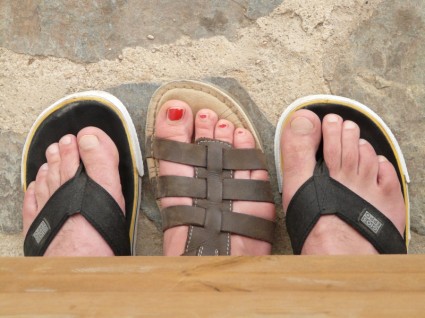
This week, please allow me to address a topic that seldom makes the top ten of health care problems: toenails. Take a moment now, and look at your toenails. Can you say with all honesty that you love and appreciate them? Or do you prefer they remain hidden under glitzy toe polish or buried in a boot or shoe? Are they the nice, symmetrical, pink-white shiny nails of youth or the horny, crusty, yellowed hooves of old age? Are they all the same color, or are some darker, green, yellow, or even black?
My inspiration to write about this came Saturday night when I had to do my bimonthly toenail trimming. Reaching them is harder every year and requires more exotic and garage-worthy equipment. For some older folks, the best bet is to let a family member, doctor, or foot specialist trim your nails. This is especially important for those with diabetes or peripheral vascular disease as a bad nail or nail infection in these folks can result in an amputation or worse.
A patient of mine with diabetes came in very concerned about a black toenail. She was sure it was diabetic gangrene. After an exam, we concluded that the blood flow was good and likely it was a bruise under the nail. Three months later when the “bruise” had not resolved, I sent her to Dermatology for a biopsy. We found that it was a melanoma, a potentially deadly kind of skin cancer growing under the nail. Off with the toe and 12 years later, she is alive and well.
In the biblical book of Corinthians, Chapter 12, it says that “Our bodies don’t have just one part. They have many parts. Suppose a foot says, ‘I’m not a hand, and so I’m not part of the body.’ Wouldn’t the foot still belong to the body? If one part suffers, every part suffers with it; if one part is honored, every part rejoices with it.”
The point of this is that each part of the body is necessary and even something like a lowly toenail has a role in good health. A pain in the nail truly does cause us travail.
As a family doctor, I have seen many a toenail, some pretty and some so ugly that they looked like the horn of a Rocky Mountain sheep. I have treated nail fungus, ingrown nails, nails in diabetics that perilously cut into vulnerable adjacent tissue, runner’s nails, acrylic damaged nails, psoriatic nails, and more.
Many medical diagnoses can be made from studying the nails. Anemic patients have a spoon shape to their pale, brittle nails. Patients with psoriasis have nails that peel back on the leading edges and look like they have been hammered with an ice pick. Patients with chronic lung disease have “clubbed” nails, which from the side, have a convex curve reminding one of a parrot’s beak. Liver, thyroid, rheumatic, and other diseases can be detected by a careful exam of the nails. Check out images on Google if you want to scratch up more info on this.
Family medicine doctors are just one of the many specialties to treat nail disease. Podiatrists, orthopedists, dermatologists, rheumatologists, and others all are in one way or another involved in treating diseases of the nail.
At the UTMB student-run St. Vincent’s Clinic, we sometimes get patients with neglected nails several inches long that make it hard for a person to even walk. This requires a surgical procedure that is somewhat like trimming a tree. With instruments that look like the dikes and bolt cutters my mechanic dad used to cut wire cables, we reduce the size of the nail. Then, using a hand held buzz saw called a Dremel tool, we grind the nail down to size. During this procedure, so much nail dust fills the air that those in the room must wear a surgical mask to avoid inhaling toe jam, toenail fungus, and other nail detritus. Lovely. Needed to be done so this man could walk.
And now to talk about the real fun. Removing nails sounds like a torture inflicted on POW’s in a death camp. However, badly ingrown nails are often best treated by partial or total removal. Unlike in the death camps, we humanely inject a digital block anesthetic so the patient feels nothing except a little pressure. With time the nail can grow back normally or if it is a repeat offender, can be ablated permanently by radio waves, heat, or chemicals.
Love your toenails, don’t ignore or detest them. Take good care of them. They serve an important protective function for your feet. Make sure you trim and care for them regularly, that your shoes fit and don’t irritate the nails, and when in doubt, check it out. While your pedicurist may offer an opinion, the safest thing is professional medical exam.
Dr. Victor S. Sierpina is the WD and Laura Nell Nicholson Family Professor of Integrative Medicine and Professor of Family Medicine at UTMB.